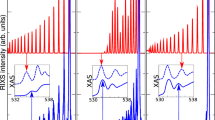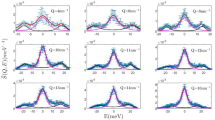Abstract
WHEN a sample is irradiated with monochromatic light of frequency ν0 and the scattered light at right angles to this incident beam examined by means of a spectroscope, a line spectrum is observed containing besides the Rayleigh component ν0, the Raman lines ν0 ± ΔEi/h, where ΔEi are the energy differences between stationary states of the sample. Although an arc having a relatively isolated line is normally used as the source of monochromatic light, all arcs do give rise to some continuum and this also appears in the spectrum as Rayleigh scattering. This continuum can be reduced by a carefully designed arc (such as the Toronto type1 mercury arc), while the Rayleigh scattering is minimized by preparation of the sample for investigation in an optically clean condition. However, even under such favourable conditions some continuous scattering does occur, but the fact that it appears to depend on the nature of the scattering medium, extending less than 100 cm.−1 from the exciting line in the case of unassociated liquids2–4 and their corresponding solids and many hundreds of cm.−1 in the case of highly associated liquids5 and solids, would suggest that it is not Rayleigh scattering as is often thought. Its origin is, therefore, of interest, and it is the purpose of the present communication to discuss the possible sources of these anomalous Rayleigh ‘wings’.
This is a preview of subscription content, access via your institution
Access options
Subscribe to this journal
Receive 51 print issues and online access
$199.00 per year
only $3.90 per issue
Buy this article
- Purchase on Springer Link
- Instant access to full article PDF
Prices may be subject to local taxes which are calculated during checkout
Similar content being viewed by others
References
Welsh, H. L., Crawford, M. F., Thomas, T. R., and Love, G. R., Canad. J. Phys., 30, 577 (1952).
Bopayya, K., Curr. Sci., 5, 532 (1937).
Sirkar, S. C., Indian J. Phys., 10, 75 (1936).
Sirkar, S. C., and Mookerjee, B. K., Indian J. Phys., 10, 375 (1936).
Nedungadi, T. M. K., Proc. Indian Acad. Sci., 8A, 397 (1938).
Herzberg, G., Infrared and Raman Spectra, 532 (D. Van Nostrand Co., New York, 1951).
Barnes, R. B., and Czerny, M., Z. Phys., 72, 447 (1931).
Krishnan, R. S., Nature, 156, 267 (1945).
Wilmshurst, J. K., and Senderoff, S., J. Chem. Phys. (to be published).
Robinson, T. S., and Price, W. C., Molecular Spectroscopy, edit. by Sell, G., 211 (Institute of Petroleum, London, 1955). I am indebted to H. J. Bowlden, of this Laboratory, for writing a computer programme to facilitate this analysis.
Author information
Authors and Affiliations
Rights and permissions
About this article
Cite this article
WILMSHURST, J. Lattice-type Vibrations in Associated Liquids and the Origin of Anomalous Rayleigh Scattering. Nature 192, 1061–1062 (1961). https://doi.org/10.1038/1921061b0
Issue Date:
DOI: https://doi.org/10.1038/1921061b0
Comments
By submitting a comment you agree to abide by our Terms and Community Guidelines. If you find something abusive or that does not comply with our terms or guidelines please flag it as inappropriate.



